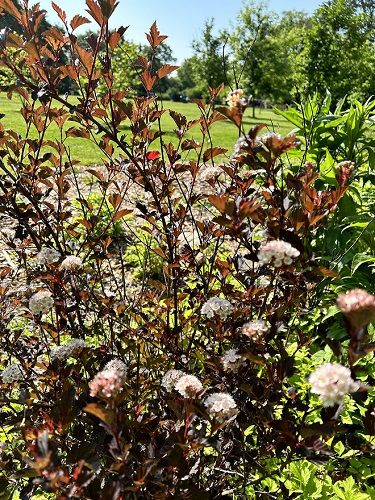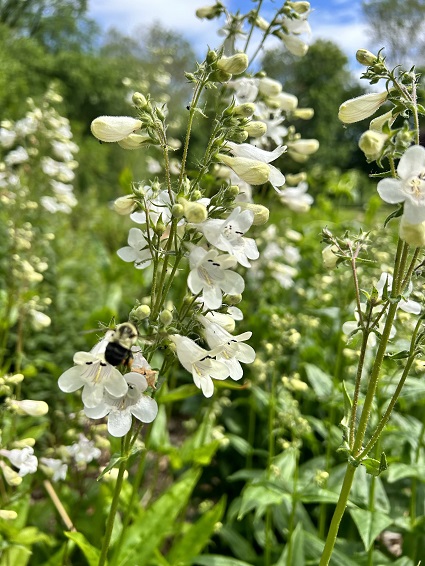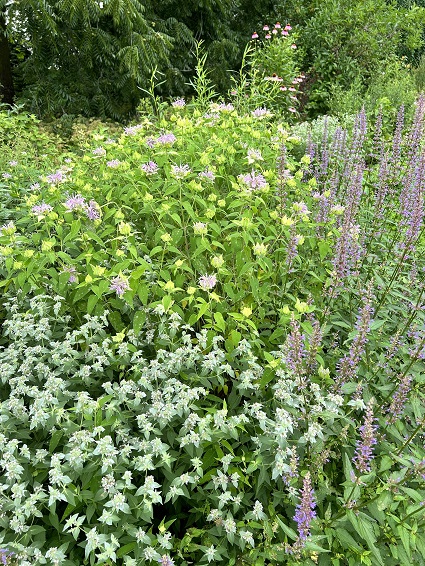Bronxville’s Native Plant Gardens at Alfredo Park are Worth a Visit

Native plant Ninebark
By the Bronxville Green Committee
Sept. 27, 2023: Something amazing has been taking place on the east side of Bronxville at Alfredo Park: Local resident Ben Lentz has been leading the transformation of what was once a wilderness of invasive weeds into a public park of gorgeous native plant gardens.
With the help of volunteers from the nearby neighborhood, Bronxville scouts, and the Bronxville Green Committee, Ben has been working for several seasons to remove aggressive, persistent knotweed, mugwort, and bittersweet—all invasive plants--and replace them with plants that are native to our area and support local wildlife.
Now you can find trees such as willows and native viburnam; shrubs such as ninebark, winterberry, and chokeberry; and flowers such as hyssop, phlox, goldenrod, and milkweed. As the flowers bloom in succession, they attract a wide variety of tiny native bees, butterflies such as monarchs and swallowtails, iridescent wasps, and even a hummingbird! And as fall arrives, the native trees and shrubs will take on color in their leaves and stems that can last all winter.
Native plant Penstemon Digitalis
Native Plants Help Reduce Flooding: The roots of native plants reach deeper into the soil than the roots of other plants. That makes them better able to survive dry spells and soak up storm runoff. In fact, Alfredo Park is situated at one of the lowest lying areas of Bronxville yet recent intense rain events have not left the standing water of previous years. One of the many steps you can take to alleviate flooding in your yard is to plant natives. Another benefit: After the first year, native plants require far less maintenance than non-natives!
Alfredo Park is an example of what a healthy landscape looks like. No chemical fertilizers, pesticides, or herbicides are applied there. Leaves and grass clippings are mulched and left on the lawn or moved into planting beds. Leaf blowers are nowhere to be seen (or heard!).

Native plant Mountain Mint
Six Elements of a Healthy Yard
Shrink your lawn: As the gardens of Alfredo expand, the lawn is getting smaller. Unless you use your lawn, you can probably plant around the edges, reducing its size, without missing it. Consider seeding with clover, which adds nitrogen and attracts pollinators, and fescue, a native grass with deeper roots that requires less water than the traditional Kentucky bluegrass.
Eliminate Pesticides: In Westchester, over 6,000 pounds of pesticides are applied per square mile each year, far more than is used for agriculture. Though pesticides are often promoted as being targeted to a specific insect, and not harmful to other living beings, that is simply not true. Pesticides move through the soil, air, and water, producing ill effects wherever they go.[i]
Add Native Plants: Fall is the perfect time to add new plants! Those that are native to our area are best suited to provide food and habitat for local wildlife. As you add native trees, shrubs, and flowers, you’ll also be doing your part to address drastic declines in biodiversity and the “insect apocalypse.”
Remove Invasives: The English ivy (and other invasive vines) climbing up the tree in your yard is bad news. It must be cut near the base of the tree, or the tree may be smothered and die. Once cut, the vine should be left alone to wither and fall off by itself. Never attempt to pull the vine off the tree, which can endanger you and further harm the tree.
Turn off the Lights: Birds and especially insects become confused, and their biorhythms disturbed, by bright lights at night. It’s one reason insects have suffered catastrophic declines in recent years. Turning off your lights, directing them downward, and putting them on motion-sensors can all help address what we now realize is a serious problem.
Reduce Your Use of Leaf Blowers: By kicking organic debris, fungus, and animal excrement into the air, leaf blowers increase respiratory diseases. Instead, leave grass clippings on the lawn to restore the soil’s nutrients. Mulch your fall leaves (or leave them whole) and place them around planting beds for even more beneficial results.
You, too, can turn your yard into a healthy landscape! A visit to Bronxville’s Alfredo Park, located across from Tuckahoe’s Cottle School on Archer Place (running one-way from Crawford to Dusenberry), may provide just the inspiration you need!
The Bronxville Green Committee is a volunteer organization that is part of the Village of Bronxville. We work to propose and implement environmentally sustainable programs in our community.
[i] Cornell Cooperative Extension and NY DEC, Pesticide Sales and Use Reporting Program
Sustainable Living Directory
The Bronxville Green Committee is a volunteer organization under Village government. We work with the Trustees and Village staff on programs that promote clean energy initiatives and sustainable ways of living. Our programs include The Bronxville Giving Garden, a community garden whose produce is donated to local groups; Take Back Day, when we collect items to be recycled; and Pollinator Pathways, which encourages adding native plants to our gardens. We believe everyone can make a difference by adopting simple, sustainable practices in daily life so we can work together to protect what we love -- our families, our homes and our town.













